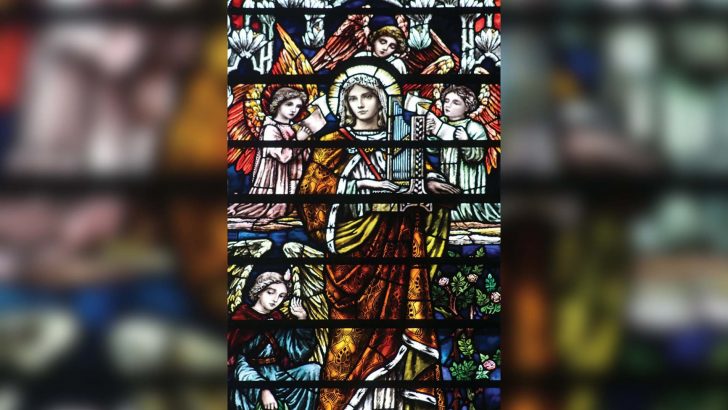Gazetteer of Irish Stained Glass, Revised New Edition
by Nicola Gordon Bowe, David Caron and others (Irish Academic Press, €35.00/£29.99)
Patrick Claffey
It is 30 years since the original publication of this handsome work, the definitive guide to Irish stained glass from 1900 to the present day. The revision, the work of several hands, is to be welcomed as it provides a comprehensive guide to an art form which, apart from Harry Clarke perhaps, is often overlooked in an increasingly secular Ireland.
It was, however, the main occupation of several of our finest artists, notably perhaps Mr Clarke (1889-1931), Evie Hone (1894-1955), Mainie Jellett, (1897-1944) Wilhelmina Geddes (1887-1955) and Michael Healy (1873-1941) but also a significant number of lesser–known figures brought to us in this scholarly volume with its outstanding illustrations.
While much Irish stained glass was created for religious purpose, it also featured widely in public buildings the most celebrated being Harry Clarke’s Geneva Windovw, created for the League of Nations building in that city. It was rejected in Ireland both by the government and the press at the time. Described by Mr Clarke’s friend and patron, Thomas Bodkin, as “the loveliest thing ever made by an Irishman”, it was eventually purchased by the American collector Mitchell Wolfson, and is now to be found at the Wolfsonian Institute in Miami Beach, Florida.
The book has an excellent introduction by Nicola Gordon Bowe, placing early Irish stained glass in a wider context and leading to the ‘inaugural tea party’ of An Túr Gloine (The Tower of Glass) at 24 Upper Pembroke Street, Dublin in 1903, a key moment in the development of the medium in Ireland. David Caron provides a very scholarly and comprehensive ‘Overview of Irish Stained, mid-Twentieth Century to the Present Day’, covering the entire island.
With 2,500 entries, the gazetteer lists the works county by county, while providing short biographical notes on the major artists. Several of the works, in churches of all the major denominations, are sometimes in quite far-flung places.
Delighted
I was delighted to find what I now know to be a Richard King (1907-1974) on Inis Meáin, eight Harry Clarkes in St Mary’s Ballinrobe, a similar number in the old convent in Dingle, another Richard King in Cong, a Wilhelmina Geddes in Currane near Achill, and a Patrick Pye, among several others, in St Mary’s in Westport.
I have a particular favourite in the Harry Clarke window over the main altar at Tullycross, Co. Galway, St Bernard, and St Barbara with Christ Revealing the Sacred Heart (1927), donated to the parish by Oliver St John Gogarty, who then owned Renvyle House.
Dublin is, of course, very well represented with work by the earlier 20th century school but, also, by post-conciliar works created following the Second Vatican Council (1962-65).
It would be interesting to know more about Sheila Corcoran and her remarkable and strikingly modern 1964 Stations of the Cross at Dublin Airport. The work was controversial, judged unsuitable and removed from the airport on the instructions of Archbishop McQuaid in 1965. Happily, it was later restored and is one of the outstanding features of that small church.
Also of interest is Patrick Muldowney’s 2000-2001 works for the millennium for the Church of St John Vianney in Artane, and Richard King’s magnificent window The Fish (Christ), 1969-70 in the chapel of Nazareth House, Dublin.
Many readers will of course, immediately seek out their own parish church and perhaps have some quibbles; in my case, St Mary’s, Haddington Road. Here the gazetteer mentions three works: A.E. Child’s St Cecilia (1904), The Baptism of Christ (1910) and William Earley’s rose window, which is dated c. early 1940s.
Two questions arise here: the Baptism has been attributed to Catherine O’Brien (1881-1963) in this edition, while in the previous edition it was said to be the work of Beatrice Elvery (1883-1970): the reason for this radical change is not explained.
Attribution
The short publication St Mary and its Environs (Spencer, Doran & Doran 1989) accepts the Elvery attribution, stating that it was done in collaboration with ‘Kitty O’Brien’, both being closely associated with An Túr Gloine.
More significant is the omission of the magnificent Christo Regi in Honorem in the east transept, to the left of the altar, also the work of William Earley and dated to the 1940s.
The rose window has also been dated by the authors to the 1940s, while it seems it was painted by Mr Earley in the 1920s. It seems probable that finance held up the installation and both works were completed at about the same time. The Christo Regi window is sometimes mistaken for a less ‘sparkling’ Harry Clarke.
In my view, it is probably the finest window in the church and this omission should be rectified in any later edition.
Other parishes will inevitably have other minor quibbles and questions – which is the way scholarship grows. This is a most welcome publication which will give much pleasure to a varied reading public, and encourage visitors to look at our churches with a new vision.
Fr Patrick Claffey SVD lectures in world religions and theology at the Loyola Institute at Trinity College, Dublin.


 A.E. Child’s St Cecilia
(1904), in Haddintgon Road, Dublin. Photo: P. Claffey.
A.E. Child’s St Cecilia
(1904), in Haddintgon Road, Dublin. Photo: P. Claffey. 